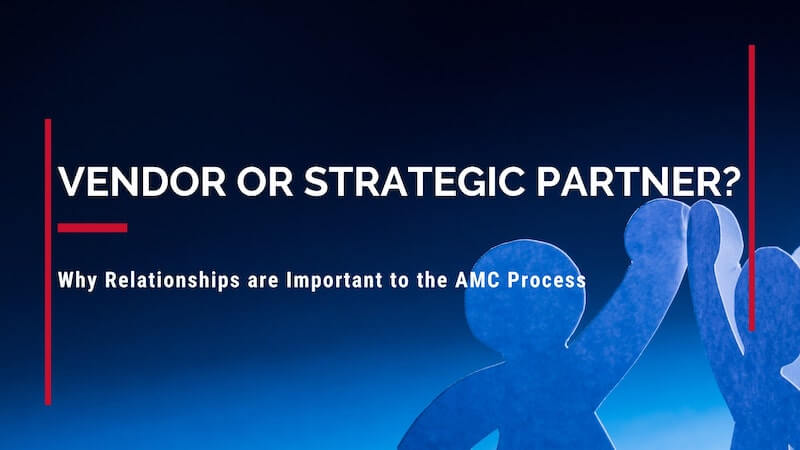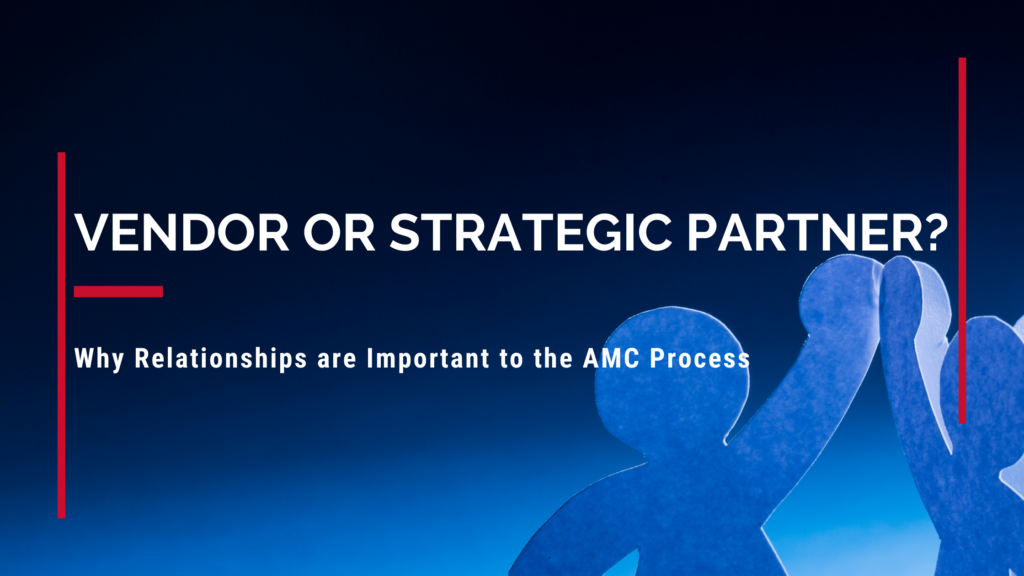‘Sorry, I am not looking for another vendor. I only engage with strategic partners.’ That should be the position of every lender out there looking for service providers. But is it?
Vendors merely transact for you and deliver little else. Vendors can be found everywhere you look. Strategic partners continually evolve to where lines may become blurred – becoming more of an extension of your organization – rejoicing in your shared successes and getting their ‘game face’ on to help identify and combat points of failure.
A senior executive (client prospect) once told us, “We are a huge and fragmented lender, with mediocre processes and procedures, propped up by outdated and clunky technology. We don’t need another vendor. We require a strategic partner that can help us overcome ourselves.”
Not sure if you caught a unique point made in the second paragraph… ‘help IDENTIFY and combat points of failure.’ Telling your clients what their problems are can be a very slippery slope, requiring a high degree of prowess and tact. Honesty builds trust, and if your relationship is not founded on trust, you likely cannot call it a relationship – not for long anyway – as it has a shelf-life with a soon-to-expire date.
We are proud that we have never lost a client since we began, wearing it like a badge of honor. But, like any service provider in a super-challenging market like financial services, we have had periodic times of struggle and adjustment (a bit of that honesty we profess). This is not surprising, considering the epic peaks and valleys of volume booms and busts, not to mention constant legal, regulatory, and compliance changes. Two things help to earn and retain client trust every day – relationships and performance.

Our 3 Relationship Pillars
It is an odd contradiction. There is a never-ending stream of online content available on vendor management (VM) in the mortgage industry. The same cannot be said for ‘vendor relationship management’ (VRM). Yet, VRM is the fundamental principle. Might this be an indication of an industry better at simply bringing on vendors rather than finding and maintaining strategic service providers over the long-haul?
We see some wild rides, with most industry veterans rarely surprised by anything that comes next. Uncertainty, volatility and shifting rules and complexities define our daily existence. This does not just ‘nip at the heels’ of lender/vendor relationships; it can rear up and take a great white sized bite, putting lenders and vendors in contention for their own episode on ‘Shark Week’ on the Discovery Channel.
More seriously, so many things are stacked against maintaining productive, healthy and thriving lender/vendor relationships. It does not happen without planning, daily execution and ongoing adjustment. The VRM strategy and plan you begin with probably won’t look the same a year later.
Here are the Top-3 key relationship management pillars we cling to:
Commitment/Reliability
We never over-commit and then under-deliver, an easy trap to fall into for many, especially during the RFP process. We likely lose some opportunity as a result. Nevertheless, for us, it is always about… Promises made are promises kept. Clients know they can depend upon us on every order, regardless of the challenges or circumstances. Should we ever hit a snag, we are quick to share the event and the plan of action. Solutions over excuses.
Transparency
Consistent quality performance makes this one easier, giving you credibility – more likely to be heard. Transparency in a B2B relationship means that anything and everything is fair game to be discussed, including the good/bad/ugly on your end and ours. Everyone needs to be focused on what’s working and what’s not, without fear of straight talk. Hinting about or sugar-coating things is weak and unhealthy, probably detrimental. Have the leadership courage to avoid telling people what they may want to hear – instead, sharing what they need to know. It’s entirely possible a little short-term ‘riff’ could happen; however, when the client understands your intent and commitment, the relationship strengthens exponentially and for the long-term.
Communication
Always and often. Define a framework or structure that guides your organization and its people.
-
- Status calls for various roles/departments (weekly for some, monthly or quarterly for others)
- Project plans to track issues and opportunities on both sides, with accountable parties and due dates
- Incident management, at an order level and separately at the organizational level (e.g., IT or phone issues, positive & negative press, cyber breach, legal/compliance, etc.)
We also consider specific individuals, at a personal level, at the lender. Some people have unique needs on what to share, how often and via which method. You cater to her/him. ‘Know Your Customer’ (KYC) is not just a regulatory and compliance requirement. We know ours.

